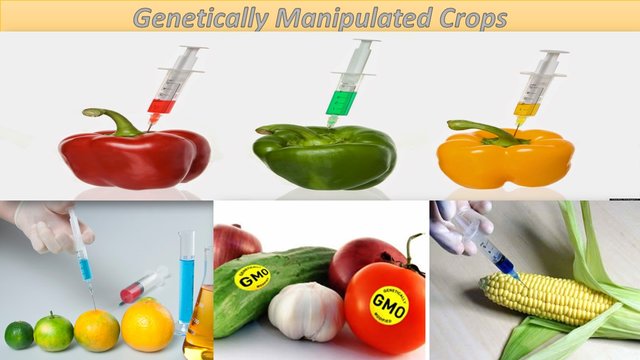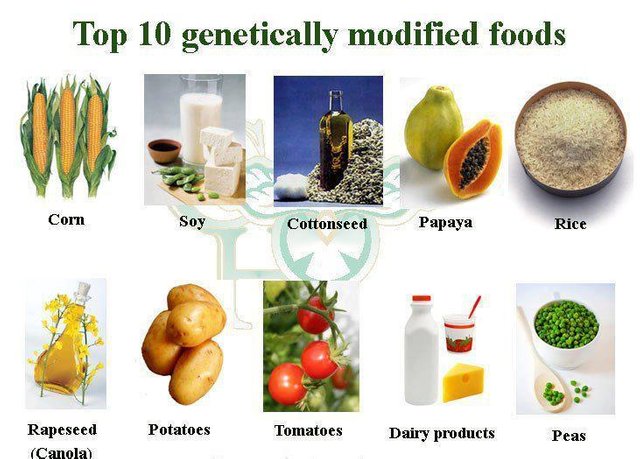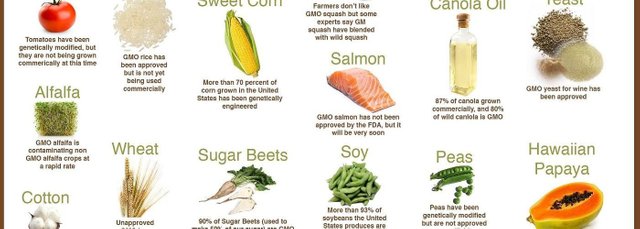Genetically Modified (GM) Crops !!
What are GM crops?
The term hereditarily changed (GM), as it is regularly utilized, alludes to the exchange of qualities between creatures utilizing a progression of research center strategies for cloning qualities, joining DNA fragments together, and embeddings qualities into cells. All in all, these methods are known as recombinant DNA innovation. Different terms utilized for GM plants or sustenances got from them are hereditarily adjusted life form (GMO), hereditarily designed (GE), bioengineered, and transgenic. 'Hereditarily altered' is a loose term and a conceivably befuddling one, in that for all intents and purposes all that we eat has been changed hereditarily through training from wild species and numerous ages of determination by people for alluring qualities. The term is utilized here in light of the fact that it is the one most generally used to demonstrate the utilization of recombinant DNA innovation. As indicated by USDA principles for natural agribusiness, seeds or different substances inferred through GM innovation are not permitted in natural creation.
Which GM crops are presently developed in the U.S.?
In spite of the fact that in the U.S. hereditarily built variants of 19 plant species have been affirmed, just eight GM edit species are developed industrially (Figure 1). Since a few of them are significant products, the territory planted to GM assortments is expansive. Most present GM crops have been designed for protection from creepy crawlies, resilience to herbicides (weed control items) or both.
What characteristics have been adjusted in GM crops?
Creepy crawly safe products contain qualities from the dirt bacterium Bacillus thuringiensis (Bt). The protein created in the plant by the Bt quality is dangerous to a focused on gathering of bugs—for instance European corn borer or corn rootworm—yet not to warm blooded creatures. The most widely recognized herbicide tolerant (HT) crops are known as Roundup Ready®, which means they are tolerant to glyphosate (the dynamic fixing in Roundup® herbicide). Glyphosate inactivates a key protein engaged with amino corrosive blend that is available in every single green plant; accordingly, it is a compelling wide range herbicide against about all weeds. Gathering Ready® crops have been designed to create a safe type of the chemical, so they stay sound even subsequent to being splashed with glyphosate. A few cultivars of corn and cotton are alluded to as 'stacked', which means they have transgenes for both creepy crawly opposition and HT. As indicated by USDA-ERS (2013), over portion of the U.S. corn and cotton real esatate was planted to stacked cultivars in 2013.
Which GM crops are developed in Colorado?
Corn, horse feed, and sugar beet are the real GM crops developed in Colorado, however littler regions of soybeans and canola are likewise planted. The corn, hay, and soybean crops are about all utilized as domesticated animals sustain. Sugar beet is utilized to extricate and refine sugar, and canola is utilized generally for consumable oil. All GM seeds are focused to business cultivators; no vegetable or organic product assortments for home generation are GM.
What are potential GM products without bounds?
Some potential utilizations of GM trim innovation are:
Nutritional improvement: Higher vitamin content; more fortifying unsaturated fat profiles.
Stress resistance: Tolerance to high and low temperatures, saltiness, and dry season.
Disease obstruction: For instance, orange trees impervious to citrus greening illness or American chestnut trees impervious to parasitic scourge.
Biofuels: Plants with changed cell divider organization for more productive transformation to ethanol.
Phytoremediation: Plants that concentrate and think contaminants like substantial metals from contaminated destinations.
How are GM crops managed in the U.S.?
Three U.S. government elements have expert to manage GM trims: the United States Department of Agriculture (USDA), the Environmental Protection Agency (EPA), and the Food and Drug Administration (FDA). They don't, be that as it may, exclusively manage all GM crops. For instance, USDA is associated with endorsing the field arrival of most GM plants, yet EPA is included just in irritation and pesticide obstruction characteristics, and FDA just directs crops bound for sustenance, encourage, or pharmaceuticals. Therefore, EPA does not have expert to control a vitamin-upgraded tomato, and FDA would not direct a dry season tolerant turfgrass. These government offices survey broad data put together by the harvest engineer, for instance, the nature and security of the transgene and its protein item, consequences for non-target life forms in the field condition, piece of the nourishment item, and potential for unfavorably susceptible response. On the off chance that the organizations are fulfilled that the proposed trim does not posture dangers to the earth and does not build dangers for sustenance or encourage security, the yield is resolved to have nonregulated status, that is, it is affirmed for commercialization.
Are GM crops developed in different nations?
As indicated by an ongoing report (James 2014), GM crops were developed in 26 different nations in 2013. The biggest worldwide land crops were soybean, corn, cotton, and canola, in a specific order. The U.S. has the best region of these harvests, around 40% of the world aggregate. Other extensive makers incorporate Brazil, Argentina, India, and Canada.
Besides GM crops, are there other GM fixings in our nourishment supply?
No GM nourishment creatures have yet been affirmed in the U.S., in spite of the fact that a GM salmon built for quick development is under survey. GM microorganisms are utilized to create rennin for generation of cheddar and GM yeast has been endorsed for winemaking .
How does GM innovation contrast from other plant rearing strategies?
The period of logical product change goes back to around 1900, when the effect of Gregor Mendel's investigations on attribute legacy in peas turned out to be generally perceived. From that point forward, a wide scope of procedures has been produced to enhance trim yields, quality, and protection from infection, bugs, and ecological pressure. Most plant rearing projects depend on manual cross-fertilization between hereditarily unmistakable plants to make new mixes of qualities. The offspring plants are seriously assessed more than a few ages and the best ones are chosen for potential discharge as new assortments. An illustration is a tomato assortment that is chosen for infection opposition and resilience to cool temperatures. Different methods included inside the customary plant reproducing tool kit are improvement of half and half assortments by intersection two parental strains to deliver posterity with expanded force; and initiated transformations to make helpful variety. GM innovation is substantially more exact in that it exchanges just the coveted quality or qualities to the beneficiary plant. Another branch of farming biotechnology—particular from GM innovation—includes choosing plants for DNA designs known to be related with positive attributes, for example, higher yield or sickness opposition.
The mutual DNA code
Most creatures store their hereditary data as DNA atoms in chromosomes. The succession of substance bases in a DNA strand encodes a particular request of amino acids, which are the building squares of proteins. Proteins complete numerous capacities in cells and tissues, which together are in charge of a living being's attributes. Since most living things share this same dialect of heredity—and because of logical advances in sub-atomic science—it is currently conceivable to exchange a quality starting with one animal varieties then onto the next, for instance from a bacterium to a plant, and have it work in its new host.
What is embedded into a GM plant?
The embedded DNA piece contains one or a couple of qualities, which contain the DNA succession data encoding particular proteins, alongside DNA portions that manage generation of the proteins. The embedded section likewise now and then contains a marker quality to effortlessly distinguish plants that have joined the exchanged qualities, otherwise called transgenes, into their chromosomes.
How are transgenes embedded?
There are two foremost techniques for transgene inclusion:
- Gene weapon:
In this strategy, minute pellets of gold or tungsten are covered with the transgene part and shot at high speed into plant cells or tissues. In a little extent of cases, the pellet will go through the cells and the DNA piece will stay behind and end up consolidated into a plant chromosome in the cell core.
- Agrobacterium tumefaciens:
This technique uses an organic vector, the dirt abiding bacterium Agrobacterium tumefaciens, which in nature exchanges some portion of its DNA into plants and causes crown irk infection. Hereditary specialists have exploited this DNA exchange instrument while incapacitating the ailment causing properties. Plant and bacterial cells are co-developed in a petri dish under conditions that encourage quality exchange. This permits consolidation of qualities in a more controlled way than with the quality weapon; in any case, it doesn't work similarly well in all plant species.
How are entire plants gotten from plant cells or tissues?
Addition of transgenes is for the most part a wasteful procedure, with just a couple of percent of plant cells or tissues effectively coordinating the remote quality. Different methodologies are utilized to recognize the little level of cells/tissues that have really been changed. The following stage is to build up those cells or tissues into entire plants fit for creating seed. This is done through a procedure called tissue culture, that is, developing plants on agar or a comparable medium within the sight of plant supplements and hormones under controlled natural conditions.
What occurs straightaway?
The yield engineers at that point start a long arrangement of assessments to confirm that the quality has been joined effectively, that it is acquired in a steady and unsurprising way, that the coveted characteristic is communicated to the normal level, and that the plant does not demonstrate any negative impacts. Assessments are at first done in controlled nurseries and development chambers. Once adequate seed is delivered and the proper authorization is gotten, test plants are developed in field trials. Field assessments take after strict rules that incorporate disengagement from related plants to evade cross-fertilization, cautious cleaning of planting and reaping hardware, visit observing of product development, and checking the field for two seasons after the trial for the nearness of volunteer plants that have emerged from seed accidentally left behind.
Quick Fact About GM Crops :
Genetic adjustment (GM) innovation permits the exchange of qualities for particular characteristics between species utilizing lab systems.
GM crops were first presented in the U.S. in the mid-1990s. Most present GM crops developed in the U.S. are built for bug opposition or herbicide resilience. Corn, soybeans, and cotton are the three biggest grounds GM crops.
GM crops developed in Colorado incorporate corn, horse feed, sugar beet, soybeans, and canola.
Potential future utilizations of the innovation incorporate nutritious improvements, stretch resilience, illness obstruction, biofuel proficiency, and remediation of contaminated locales.
GM crops are directed at the government level by the U.S. Bureau of Agriculture (USDA), the Environmental Protection Agency (EPA) and the Food and Drug Administration (FDA), each with specialist to supervise particular parts of the yields and their items.


